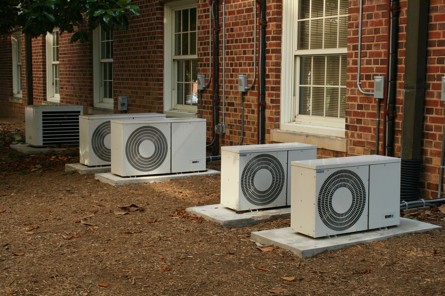The suction line in HVAC units is a pipe that connects the outdoor air conditioner or heat pump to the indoor evaporator coil. It sucks outside air into the house and forces it through the return ducts. This helps prevent moisture from entering the home and condensing inside the walls.
To get the most out of your HVAC system, you need to understand how an AC suction line works. And understanding how your unit works means knowing how important components such as the suction line are.
If you’ve never installed a suction line before, then this article will teach you everything you need to know. We’ll go over what a suction line is, why it is essential, and how to find the correct size suction line.
How does the Suction Line work?
Two copper lines in an AC unit serve as refrigerant lines. The larger line that carries cool gas and is usually insulated is the suction line. The other refrigerant line is a smaller uninsulated line that carries warm liquid and is often called the liquid line.
A suction line runs from the outdoor unit (the part of the HVAC system that heats and cools your home) to the indoor unit (the part of your HVAC that blows warm or cold air). The return line sucks outside air into the house, where it passes through the return ducts and circulates throughout the entire building.
While this process is happening, the suction line in the HVAC also pulls any moisture out of the air. When the air leaves the return ducts, it’s drier than when it entered the house. This prevents moisture from entering the walls and causing damage and also keeps the indoor air quality high.
When running your air conditioner and heat pumps, a common problem is the suction line freezing. When this happens, the airflow stops working properly. As a result, the air conditioner doesn’t cool down the room as efficiently as it should.
When the suction line in HVAC systems freeze, they become clogged with dust and debris. This causes the airflow to slow down, making it harder for the air conditioner to work its magic.
You must remove all the dirt and debris from these suction lines and replace your air filters to fix this issue. You can do this by unclogging the copper lines with a vacuum cleaner.
So, now that we’ve covered what a suction line in HVAC is, let’s talk about why it’s so important.
Why do you need an HVAC Suction Line?
Installing a suction line is an easy way to improve the efficiency of your HVAC unit. If you have a terrible suction line, you could be losing refrigerant, and your unit may be working harder than it needs to be. A clogged suction line could cause the air conditioner or heater to overheat or undercool your home, leading to high energy bills.
You can install a suction line yourself if you’re comfortable working around an HVAC system. However, many homeowners hire professional HVAC contractors to do the job.
If you are having trouble getting warm air into your home, it could be due to a faulty suction line. This can cause many problems such as poor airflow, low heating capacity, and increased Energy Bills.
How do I know if my Suction Line needs Replacing?
Several signs indicate whether your suction line needs replacing. Some of these include:
-
Your furnace or heat pump doesn’t seem to be running at full capacity
-
You notice cold drafts coming out of vents throughout your home
-
You notice hot spots in rooms where the thermostat isn’t set high enough
-
Your energy bills are higher than they used to be
-
You notice condensation dripping down walls
-
You hear loud noises when turning on the furnace
Hurliman Heating and Air Conditioning recommend calling an HVAC technician to inspect your suction line. We will determine whether or not your current suction line needs to be replaced.
We also recommend using a suction line accumulator to protect your HVAC system against potential hazards such as compressor damage.
What does a Suction Accumulator do?
Air-source heat pumps must maintain equilibrium and operate at heating levels of the environment to cool the compressor and avoid excessive refrigerant flood back.
To prevent the compressor from liquid refrigerant flooding due to a leaky pipe that could damage the reed valves, pistons, and crankshaft, the accumulator intercepts the liquid refrigerant before reaching the compressor.
The accumulator acts as a receiving device during the cooling and heating cycles when the system overcharging from field service could overload the system with liquid refrigerant.
It stores excess refrigerant in a separate chamber during regular operation until the system needs more refrigerant. During heating cycles, the accumulator releases the refrigerant into the compressor at controlled rates, while in defrost cycles, the accumulator absorbs the refrigerant from the system.
The refrigerant accumulator’s maximum capacity, expressed in tons, should not exceed a pressure drop equivalent to 1°F.
Choosing the Right HVAC Suction Line Size
It’s important to note that you should only install the correct size if you’re replacing your existing suction line. Otherwise, you could end up with a leaky connection. The suction line size is usually 3/8, 7/16, 5/16, or 1/2 inches, depending on the size and performance of the HVAC system.
You might think that having a large enough suction line would allow the HVAC system to pull in a larger volume of air. But that isn’t necessarily true.
The reason is simple: the air conditioner only needs to suck in enough air to cool down the space below the evaporator coil. So if your house is small, you probably won’t need a huge suction line. However, if your house is bigger than average, you may need a bigger suction line.
To figure out how much suction line you need and avoid experiencing problems with airflow, always check the manufacturer’s recommendations for the size of the suction line.
If they recommend a larger diameter, then you should consider going with a bigger diameter suction line. However, if the manufacturer recommends a smaller diameter, you should probably stick with the recommended size.
The Bottom Line
An HVAC suction line is vital to the performance of an HVAC system. If your suction line is frozen or not properly installed, you’ll have poor air quality, poor heating/cooling, and increased wear and tear on your HVAC system.
To prevent these problems and ensure that your HVAC system performs at its peak, get in touch with an HVAC maintenance expert to keep your suction line clear and insulated.






